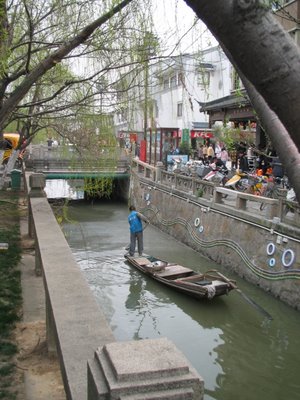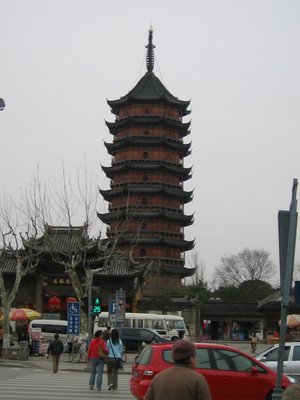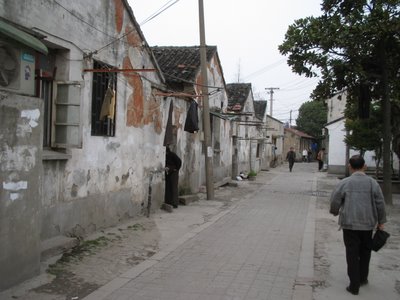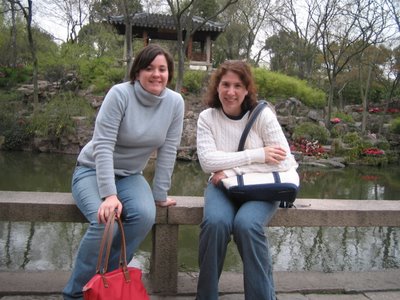China part 2 – Xian and Suzhou 3/21-3-23
Tuesday
Our train arrived in Xian at around 8:30 on Tuesday morning. After about 12 hours on the train, you can imagine how ragged we all looked and felt. We walked about 15 minutes down a shabby street of shops and street vendors to where our bus was parked. We boarded the bus and drove into the city center.
Xian is one of the few remaining walled cities in the world, and it’s also one of the few cities in China that wasn’t attacked during World War II, or as the Chinese call it, The Anti-Japanese War. Because Xian was never attacked, its city wall and surrounding moat remain perfectly intact; Xian is referred to as the City of Everlasting Peace.
Street in Xian

We had a couple hours in the hotel to shower and refresh before Anthony took us on a walking tour of the city. Xian is Anthony and Howard’s hometown so they had a lot of things to say and quite a lot of pride for the city. First we walked through the Muslim Quarter of the city, past their markets and the Great Mosque. Xian has a very large Muslim population because of its location at the beginning of the Silk Road. We then found ourselves in the center square where the famous Bell and Drum Towers are.
The Drum Tower

View of the Bell Tower at night from our hotel window

We walked through a big shopping area, onto a street full of bars and cafes before stopping for lunch at a pseudo-Japanese restaurant. After lunch we walked to the City Wall, where for a small entrance fee, we were allowed on top of the wall which runs the 14km circumference of the city. Anthony left us there for a free afternoon of exploration.
Market in Muslim Quarter

Kate and I had planned to rent bikes to ride along the wall, but the day was a bit rainy (our only day of bad weather, by the way), so we decided to pass on that plan. We strolled along the wall for a while, but ultimately weren’t that impressed by the view it offered, so we eventually climbed down. We spent the rest of the day perusing the Muslim Quarter, buying random souvenirs for which I bargained with a vengeance with the hard-as-nails shopkeepers; we ended the day by visiting the Great Mosque.
South Gate of the wall

On the wall

The Mosque was beautiful. It was built in 742 and has been restored many times. Around 5 o’clock, all of the men (women can’t pray at this Mosque) emerged from praying in the temple in their white and black hats. The black hats symbolize the few men who have already made the requisite pilgrimage to Mecca. The men in black hats were few and far between. We learned that China is only allowed 200 visas per year to Saudi Arabia, so many Chinese Muslims, despite being financially and physically ready for the pilgrimage, must wait many years to get a visa to enter.
Courtyard of the Great Mosque

Wednesday
We met the group at 9:30 for the daytrip to see the Terracotta Warrior Museum (the 8th Wonder of the World), located about an hour outside of Xian. The museum is currently made up of three pits of warriors. Pit 1, at 14,260 sq meters, is the biggest and so far, the best recovered and preserved. It consists of 5 sections of about 6000 warriors, 5 meters deep, in battle formation, facing east. Pit 2 contains 1,000 warriors, 500 horses, and 89 wooden chariots. And in Pit 3 there are about 68 warriors, four horses and one chariot. They are not placed in battle formation and because of its depth and distance from Pit 1, archaologists assume this group was the command center for the others.
Life-sized warriors in Pit 1


The 8000+ warriors were built in the 200s BC to protect the grave of Emperor Qin Shi Huang in his huge mausoleum. Shortly after his death, during the peasant revolution, the grave was attacked and torched; the bronze weapons they held were stolen. During the fires, the wooden beams supporting the ceiling of the mausoleum collapsed, burying the warriors until the 1970’s when a farmer accidentally discovered them. He had been digging a well on his farmland and he discovered a piece of sculpted terracotta from one of the warriors. He alerted whoever-it-is-you-alert-when-you-find-a-world-wonder-in-your-backyard, and soon enough his farmland was turned into a major archeological dig site. He was actually on site at the museum signing souvenir books. I put down the 120yuan for the book, the signature and a little wave from the cute old man. Unfortunately, and understandably, no photos were allowed, but Anthony said that this man signs more signatures in a year than anyone else in the world. The site is still undergoing a lot of digging as the archaeologists discover more statues and develop better means of restoration. Anyway, it was awesome.
After the museum we headed back into Xian where we ate lunch at the Huiling School for Mentally Disabled People. The students did performances for us and we sang and danced with them for a while afterwards. It was lovely and very touching. I think I’ve learned a lot through working with children in Japan because I noticed that I was pretty much the only person who, despite language differences, could play and communicate with the students. Everyone else kind of freaked out and stuck with the English-speaking adults who could facilitate their communication efforts.
Kids at the school

Anyway, we then headed back to our hotel to pack up our stuff, headed to the station and boarded yet another overnight train. This time our destination was Suzhou.
Thursday
Our overnight train to Suzhou was significantly longer than the first one, about 15 hours this time. But because the train arrived in Suzhou at about 10:30, we were able to sleep in a bit, which was nice. Oh, and the toilets on this one actually flushed, so not so nasty this time. Yeah, I know you didn’t need to know that…
The weather in Suzhou was gorgeous – sunny and warm. So after a couple hours to refresh, we headed off on a walking tour of Suzhou. Suzhou is an old water town, with canals running through the city. Anthony told us that Suzhou is a pretty small city with a population of 5 million (yeah, 5 million is small for China). The city was bustling with families and young people walking around. The streets were chaotic with vehicles, pedestrians and motorized bikes fighting for space on narrow roads. The traffic in Suzhou really bothered me because drivers were very liberal with their horns and the motorbikes had only handbrakes with screeches that ran through your eardrums, into your body and rattled your bones. Oh, just thinking about it makes me wince.
Canals in Suzhou

After the guided tour and group lunch, Kate and I took off to a Taoist temple in the city center.

Then we hopped a taxi to Beisi Ta, Suzhou's North Temple Pagoda which was closed for restorations, unfortunately.

We ambled around neighborhood near the pagoda to get a glimpse of how the locals live and then made our way to the Humble Administrator’s Garden, Zhousheng Yuan which was built in the Ming Dynasty. The Garden was my favorite part of Suzhou. It was immaculate and quiet. It was so nice to be away from the sounds of the city, and because we went in the last hour, we didn’t run into many tourists.


At 7, we met with the group for a dinner for famous Chinese dumplings which were really nice. And then we went to the Master of the Nets performance at Wangshi Yuan Garden. This garden was started in 1140 and restored to its present layout in 1770. The performance was really great. It was a series of about ten 5-minute performances of famous Chinese stories, songs and dances with English explanations beforehand. I really enjoyed it because unlike Japanese art, which in my opinion is long and boring (think Noh, Kabuki), the Chinese art was entertaining, lively and short, ahem.
The garden at night

After the show, Kate went and bought a bunch of bootleg DVDs. I resisted the urge. And we went for a drink at a local pub with some of our traveling companions. The bar was randomly decorated with pictures of Marilyn Manson of the first floor and Mao Zedong on the second. The entertainment was provided by a Chinese dude covering Eric Clapton and random boy-band songs. Um, we didn’t stay long.
We returned for the hotel to rest up for the final leg of our trip, Shanghai…
1 Comments:
Depending on how you look at it this may be publicly admiting my lack of knowledge about Chinese culture, or it may by vocalizing a larger problem with the history curriculum in US public schools, but either way I have a question. Is religion allowed in China? I mean I know it must be due to your pictures and descriptions, but isn't it somehow mandated by the government/restricted to one religion? please enlighten me.
コメントを投稿
<< Home